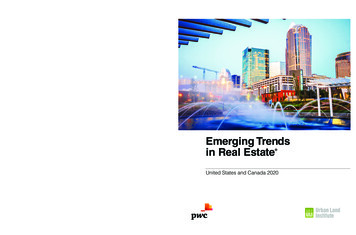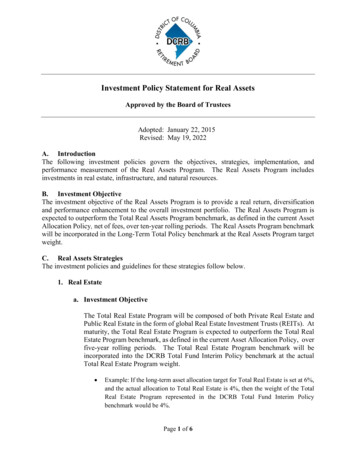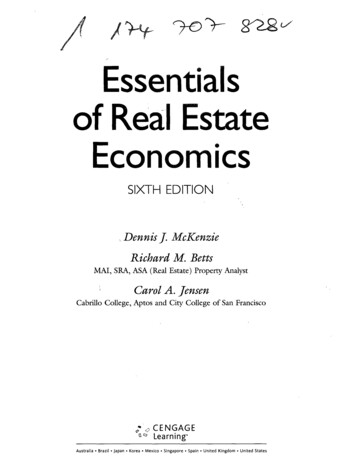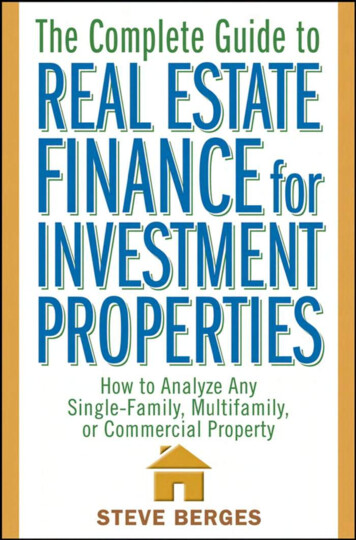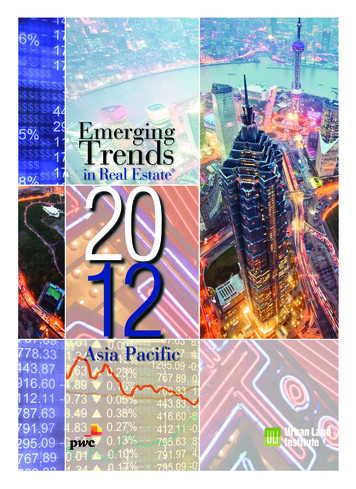
Transcription
EmergingTrendsin Real Estate2012 Asia PacificETasia 2012 CVR1 4.indd 311/10/11 10:21 AM
Emerging Trends in Real Estate Asia Pacific 2012A publication from:ETasia 2012 CVR1 4.indd 411/10/11 10:21 AM
EmergingTrendsin Real Estate Asia PacificContents1ET AsiaPacific-2012.indb 1Executive Summary247781010141517Chapter 1 Crisis and OpportunityPricing SoftensJapan Shrugs Off CalamityRegulators Step InThe Rebirth of CoreOpportunity WanesFinally, Some DistressEmerging Emerging MarketsCapital Flight?Debt: What Lies Beneath?18222324252526283030Chapter 2 Real Estate Capital FlowsSovereign Wealth Looks OffshoreFundraising FallsForeign Funds Target AustraliaCurrency RiskBanksAlternative Financing ChannelsCapital MarketsCMBSREITs323447Chapter 3 Markets and Sectors to WatchTop Investment CitiesProperty Types in Perspective50Interviewees201211/16/11 9:34:19 AM
Editorial Leadership TeamEmerging Trends in Real Estate Asia Pacific 2012 ChairsK.K. So, PwCPatrick L. Phillips, Urban Land InstitutePrincipal Authors and Senior AdvisersColin Galloway, Urban Land Institute ConsultantCharles J. DiRocco, Jr., PwCSenior Advisers and Contributing ResearchersStephen Blank, Urban Land InstituteAnita Kramer, Urban Land InstituteSenior AdvisersJohn Fitzgerald, Urban Land InstituteDean Schwanke, Urban Land InstituteContributing ResearcherMichael Owen, Urban Land InstituteEmerging Trends in Real Estate is a trademark of PwC and is registered in the United States and other countries. All rights reserved.“PwC” is the brand under which member firms of PricewaterhouseCoopers International Limited (PwCIL) operate and provide services.Together, these firms form the PwC network. Each firm in the networkis a separate legal entity and does not act as agent of PwCIL or anyother member firm. PwCIL does not provide any services to clients.PwCIL is not responsible or liable for the acts or omissions of any ofits member firms nor can it control the exercise of their professionaljudgment or bind them in anyway. This document is for generalinformation purposes only, and should not be used as a substitute forconsultation with professional advisers. November 2011 by PwC and the Urban Land Institute.Printed in Hong Kong. All rights reserved. No part of this book may bereproduced in any form or by any means, electronic or mechanical,including photocopying and recording, or by any information storageand retrieval system, without written permission of the publisher.PwC Advisers and ResearchersAustralia Andrew ClokeBrian LawrenceJames DunningManuel MakasMark HaberlinTim PeelChina/Hong Kong Alan HoAndrew LiJonathan ChangKathleen ChenK.K. SoPaul WaltersSally SunSam CrispinIndia Jai MavaniGautam MehraJapan Hiroshi TakagiRaymond A. KahnTakeshi ShimizuJulien GhataHideo OhtaMikito YoshidaKorea Hyung-Ju ChoiJin-Young LeeTaejin ParkYongJoon YoonLuxembourg Kees HageJustin OngKenneth Kai Siong IekMalaysia Jennifer ChangPhilippines Malou P. LimSingapore David SandisonEng Beng ChooJovi SeetWee Hwee TeoChen Fah YeeBenjamin KanMoi Lre KokChris WooTaiwan Richard WatanabeShuo-Yen LinThailand Paul StittVietnam David FitzgeraldULI Editorial and Production StaffJames A. Mulligan, Managing Editor/Manuscript EditorBetsy VanBuskirk, Creative DirectorAnne Morgan, Cover DesignDeanna Pineda, Muse Advertising Design, DesignerRecommended bibliographic listing:PwC and the Urban Land Institute. Emerging Trends in Real Estate Asia Pacific 2012. Washington, D.C.: PwC and the Urban LandInstitute, 2011.ISBN: 978-0-87420-175-8ULI Catalog Number: E46iiEmerging Trends in Real Estate 2012ET AsiaPacific-2012.indb 211/16/11 9:34:19 AM
Executive SummaryGoing into the final quarter, sentiment in Asian real estate marketsdeclined significantly as investors came to grips with theextent of the problems in the U.S. and European economies.Transaction volumes across most of the region fell steadily during theyear, with prices beginning to fall in some markets. This happeneddespite the fact that economies across most of Asia have been buoyant, if not overheated. Once again, therefore, Asia’s real estate marketsare hostage to events elsewhere in the world.Nonetheless, the impact of local conditions should not be underestimated. In some of Asia’s biggest economies, real estate reversalshave occurred in part because of the actions of local regulators whohave choked off bank lending to developers after four years of looseeconomic policy, causing prices to balloon. In Hong Kong, Singapore,and Taiwan, authorities have also introduced macro-prudential policiesto combat rising home values, while base rates in India have shot up toan unprecedented 9 percent in response to rising inflation.More generally, Asia’s stubbornly high prices have also had animpact on fund activity. The big returns of 20 to 30 percent, which havehistorically drawn many opportunistic investors to Asia, have dried up inmany countries, and for a variety of reasons markets generally are moremature and less risky. Sellers are not interested in cutting their prices,and local investors are prepared to pay higher prices because they areless concerned with cap rates and more willing to make a bet on capitalappreciation.With the emergence of many large institutional investors, opportunity investing has been eclipsed in many parts of the region. Be theysovereign funds, large pension funds, or insurers, many deep-pocketedinvestors (largely from within the region) are now on the prowl for coreassets in developed markets such as Japan and Australia.Despite the problems facing opportunistic investors, distress is notdead. In fact, after four years of frustrated expectations, investors arenow finally seeing opportunity for distressed investing—first, in Chinaas cash-starved developers become increasingly desperate to payupcoming bills, and also in India as the cost of bank funding drivesdevelopers to private equity as a last resort.On the financing side, fund flows within the region have seenincreasing volatility over the second half of 2011, especially on thecapital markets side, as foreign investors who are fearful of renewedeconomic crisis in the West withdraw capital back to their home markets. That said, local banks remain the biggest source of funding forreal estate investment in Asia, and while investors have seen spreadswiden in some markets (most obviously China and India, but also HongKong and Taiwan), banks remain very open to providing funds to theright investors and projects in other markets (Japan and Singapore).Probably the most popular regional market for real estate investors in 2011 has been Australia, where commercial assets have beenreadily available and cap rates remain a healthy 8 percent—far higherSurvey Responses by Geographic Scope of FirmGlobal Firm with aGlobal Strategy 27.2%Asia Pacific Firm with aPan–Asia Pacific Strategy 24.9%Other 6.1%Asia Pacific FirmFocused Primarilyon One Country 41.8%Source: Emerging Trends in Real Estate Asia Pacific 2012 survey.than elsewhere in Asia. With local investment constrained by reluctantbanks and high Australian base rates, local buyers have had problemscompeting with deep-pocketed foreign funds, which continue to look toAustralian assets despite the risks implicit in buying such a strong localcurrency.In the Emerging Trends Asia Pacific investment prospect ratings,respondents nominated Singapore, Shanghai, and Sydney as themost attractive destinations. Singapore continues to be a magnetfor foreign funds and regional investors alike, but some intervieweesquestion whether this will continue. Not only is the export-orientedcity especially subject to global economic problems, but cap rateshave become extremely compressed and an oncoming flood of newcommercial office space is likely to have a depressive impact on themarket in 2012. Shanghai is another destination that has long beenon the must-buy list for international fund managers. Again, however,very strong demand from local buyers has pushed prices to levels atwhich foreigner investors more conscious of risk-adjusted returns maybalk. Prospects in China’s second-tier destinations such as Chongqing(which placed fourth in the survey) may therefore prove more attractive.Finally, Sydney’s popularity is no surprise given the extremely attractivecap rates and fairly liquid market, as well as generally lukewarm buying interest from local investors. Industrial/distribution is the top-ratedsector across the Asia Pacific region, followed closely by residential,both for-sale and rental. The hotel sector is least favored, and office andretail fall in the middle range.Notice to ReadersEmerging Trends in Real Estate Asia Pacific is a trends and forecast publication now in its sixth edition, and is one of the most highly regarded and widelyread forecast reports in the real estate industry. Emerging Trends in RealEstate Asia Pacific 2012, undertaken jointly by PwC and the Urban LandInstitute, provides an outlook on real estate investment and developmenttrends, real estate finance and capital markets, property sectors, metropolitanareas, and other real estate issues throughout the Asia Pacific region.Real Estate Service Firm24.9%Private Property Company, Investor, or Developer22.5%Institutional/Equity Investor or Investment Manager20.7%Other Entity13.1%Emerging Trends in Real Estate Asia Pacific 2012 reflects the views ofover 360 individuals who completed surveys or were interviewed as apart of the research process for this report. The views expressed herein,including all comments appearing in quotes, are obtained exclusivelyfrom these surveys and interviews, and do not express the opinions ofeither PwC or ULI. Interviewees and survey participants represent a widerange of industry experts, including investors, fund managers, developers, property companies, lenders, brokers, advisers, and consultants. ULIand PwC researchers personally interviewed more than 150 individuals,and survey responses were received from more than 210 individuals,whose company affiliations are broken down here:Equity REIT or Publicly Listed Property Company6.1%Homebuilder or Residential Land Developer3.8%Bank, Lender, or Securitized Lender8.9%Throughout the publication, the views of interviewees and/or surveyrespondents have been presented as direct quotations from the participant without attribution to any particular participant. A list of the interviewparticipants in this year’s study appears at the end of this report. To allwho helped, the Urban Land Institute and PwC extend sincere thanksfor sharing valuable time and expertise. Without the involvement of thesemany individuals, this report would not have been possible.Emerging Trends in Real Estate Asia Pacific 2012ET AsiaPacific-2012.indb 1111/16/11 9:34:19 AM
ET AsiaPacific-2012.indb 211/16/11 9:34:23 AM
c h a p t e r1Crisis andOpportunity“There’s an opportunity for the first time to buy into assets at below replacement cost. That’s new or that’s different. So my knee-jerk reaction todaywould be toAgo out and buy something.”s the theater of Greek financial distress inches steadilytoward its climax in the final quarter of 2011, Asianinvestors have been struck by a dawning sense of déjàvu. Local real estate markets, riding the slipstream of Asia’sgrowth in gross domestic product (GDP) since 2009, havemotored along at a steady clip since the region’s V-shapedrecovery at the beginning of that year. With the good timesrolling, it was easy to discount the economic malaise gnawing remorselessly at consumer confidence in the West. Butthe reality is that Asian economies remain closely linked todeveloped markets via trade and financial channels, and theidea that they can outrun external exigencies is as unrealistictoday as it was in 2007. What’s more, if previous experience isany guide, the storm clouds now gathering on Western horizons may be barreling up behind them faster than they think.Local investors now casting a wary eye behind them shouldremember, therefore, that apparently sunny skies can beillusory. After all, objects in the rear-view mirror may be closerthan they appear.Until recently, Asian real estate markets had been enjoying at least fair returns and a generally positive outlook. Asiahas no shortage of investment capital, and until the middle of2011 there was more concern over inflationary pressures thanlack of demand. Suddenly, however, the prospect of a globalrelapse into recession is creating mounting unease. As oneinterviewee puts it, “Things have now changed from a glasshalf full to a glass half empty. I think we’re in a twilight zonewhere something’s got to give.”This sense of unease has been shared by several regionalgovernments, although for different reasons. Japan, anxiousto provide support in the wake of its natural disaster, hasExHIBIT 1-1Survey Responses by Country/TerritoryChina 9.4%India 7.6%Other 6.1%Singapore 10.4%Philippines 4.7%South Korea 3.8%Thailand 1.4%Australia14.6%Japan 26.4%Hong Kong 15.6%Source: Emerging Trends in Real Estate Asia Pacific 2012 survey.provided direct backing by, for example, buying real estateinvestment trust (REIT) shares in the open market. Hong Kongand Singapore have introduced macro-prudential measuresaimed at heading off potential housing bubbles created bytheir economic links to American interest rates or the U.S. dollar. And in India and China, authorities have effectively cut offaccess to bank funding for their domestic real estate sectorsas a means either to address inflation or to save banks fromsinking into a morass of bad debt.Quite unexpectedly, even as transactions begin to slowacross the region and pricing seems set to retrench, it is inEmerging Trends in Real Estate Asia Pacific 2012ET AsiaPacific-2012.indb 3311/16/11 9:34:23 AM
ExHIBIT 1-2Firm Profitability Forecast for 2012Prospects for Profitability in 2012 by Percentage of Respondents1.6%Very Good30.6%Good9.3%Very Good2.1%ExcellentSource: Emerging Trends in Real Estate Asia Pacific 2012 survey.China and India that opportunity has arisen. As one fundmanager observes, “What you have in India and China iscompanies with multiple projects that now can’t get the liquidity they need, or it’s overpriced. These are all opportunitiesthat were largely nonexistent when the banking system wasflush with cash, interest rates were lower, or you could gointo the high-yield market. Now that’s shut down, and there’san opportunity for the first time to buy into assets at belowreplacement cost. That’s new or that’s different. So my kneejerk reaction today would be to go out and buy something.”Pricing SoftensPrices and rents in Asia bottomed out around the beginning of2010 and saw generally strong gains in the first nine months of2011. Yields, as usual, vary widely from a low of around 3 percent in Hong Kong to about 8.3 percent in Australia. However,transaction volumes across the region began to dip at theExHIBIT 1-3Real Estate Firm Profitability rce: Emerging Trends in Real Estate Asia Pacific 2006–2012 surveys.42012start of the year and have dropped off again going into thefinal quarter. As one pan-regional analyst comments, “We areseeing selective signs of slowing in either volumes or prices,or both, in a number of property markets around the region.”Values and yields have so far remained reasonably buoyant,but with borrowing costs rising in many jurisdictions, this maynot last. According to one interviewee, “Interest rates aren’tgoing up in terms of base rates, but spreads are. Whereasbanks would be asking for, say, 200 bps [basis points] inHong Kong and about the same in Singapore, now they arepushing it out to 350–400 bps. That makes a big difference.So, at the moment we’ve got a hiatus in the market where sellers are still hoping for ridiculous prices, but buyers are saying,‘Hang on, something’s changed,’ and that’s not been factoredin.” Interviewees overall offer a cautious or pessimistic take onthe coming year, with most expecting a prolonged period ofinertia and seeing little prospect of a quick turnaround.In China, a government-imposed credit squeeze is bringingreal pain for developers. Unlike the last such episode in 2007,interviewees do not expect an early or significant easing in policy. Meanwhile, residential transaction volumes have plunged,and prices are beginning to turn negative. In Beijing, developers began offering steep discounts in late October as theycame under pressure to repay various types of loans by theend of the year. In Shanghai, transactions dropped a remarkable 72 percent year-on-year in the first three weeks of October,reaching their lowest level since 2004, according to Soufun, aprivate property research firm. Price cuts of between 20 and 40percent were reported at the beginning of November.However, the commercial sector remains strong. Cap ratesfor prime offices in tier-one cities have been squeezed as lowas 2 to 3 percent, according to one Shanghai-based interviewee, well below China’s one-year base lending rate of 6.56percent. At these levels, prices are unlikely to be attractive toforeign investors, but buying interest from domestic playersremains strong anyway, even in the face of a “quite alarming”pipeline of new supply. Apart from the fact that China hasnever been a yield-driven market anyway, there is a variety ofreasons for this:Emerging Trends in Real Estate Asia Pacific 2012ET AsiaPacific-2012.indb 411/16/11 9:34:23 AM
Chapter 1: Crisis and OpportunityExHIBIT 1-4Global Sales Volume150Asia Pacific120US BillionsEurope, Middle East, and 1Q2Q3Q42010Q1Q2Q3Q42011Q1Q2Q3Source: Real Capital Analytics, www.rcanalytics.com.Notes: Based on commercial, apartment, and hotel properties and portfolios valued at US 10 million or more. Figures exclude land values. Government restrictions are driving increased investmentinto the commercial space by developers normally focused onresidential projects. Domestic insurance companies have recently begun toinvest assets in real estate and are about to ramp up buying.Sentiment, therefore, is supported by about US 80 billion innew funding available for commercial real estate purchasesthat will create a “perfect storm” of investment in coming years. China’s emerging corporate giants want trophy assets. Asone analyst commented, “One of the things we’re seeing isa number of large [domestic] companies that look down theroad and see [foreign firms] with their own buildings and alight on the top, and say, ‘We want one of those as well.’” There is still a shortage of top-drawer buildings. “It’s frothy,but there’s a shortage of good-quality stock, so people whowant to buy have to pay a premium. I think rents will catch up:Shanghai is going to run out of centrally located office spacefairly quickly.” Fundamentally, investors believe that ongoing economicgrowth will allow the market to grow into higher prices as it hasin the past.Elsewhere in Asia, transactions of commercial properties have dropped and cap rates are either moving out or areexpected to do so. Hong Kong, for example, which has had astrong run since 2010 and features the region’s highest rentsand capital values, is always sensitive to macro trends. Onelocal fund manager, referring to a recent purchase at a yield of4.5 percent, says that until recently sellers might have soughta rate as low as 3 percent for the same deal. As a result, “Theboot’s on the buyer’s foot at the moment. We’ve seen caprates increase on the back of fewer transactions, and anybodywho has wanted to sell has had to be a little more realistic.”ExHIBIT 1-5Quarterly Cap Rates for Commercial PropertyTransactions by Zone9%Americas8%Europe,Middle East,and Africa7%6%Asia Pacific5%2007Q12008Q12009Q12010Q12011Q1Source: Real Capital Analytics, www.rcanalytics.com.Note: Based on properties and portfolios valued at US 10 million or more.Excluding one major deal, the number and value of commercial transactions in Hong Kong dropped by more than halfin the third quarter of 2011 from the previous three months,according to consultants DTZ. Transactions in the residential sector have seen a similar slump following strong priceincreases in the previous two years.Singapore has experienced a similar “aggressive” pricingdynamic in both commercial and residential markets. “It’shot and slowing, which is a very bad combination going in.”Despite its recent popularity, however, and unlike Hong Kong,Emerging Trends in Real Estate Asia Pacific 2012ET AsiaPacific-2012.indb 5511/16/11 9:34:24 AM
ExHIBIT 1-6Average Grade A Office Rent and Capital Value, Third Quarter 2011Grade A RentUS per Square Meter Quarterly Changeper Year(Local Currency)Grade A Capital ValueUS per SquareQuarterly ChangeMeter(Local Currency)Hong Kong (Central)1,739-0.9%50,2390.8%Tokyo (CBD 3-kus)Singapore (Raffles Place)Beijing (CBD)Shanghai (CBD Overall)Mumbai (SBD BKC)Perth (CBD)Ho Chi Minh City (CBD)Seoul (CBD)Taipei (Xinyi)Delhi (SBD)Sydney (CBD)Melbourne (CBD)Manila (Makati CBD)Jakarta (CBD)Kuala Lumpur (City Centre)Bangkok (CBD)Bangladore 2%2.8%0.0%4.8%1.8%4.4%14.2%0.6%1.8%2.2%Source: Jones Lang LaSalle.Notes: All rents are net effective. Rents and capital value are on a net lettable basis. Quarterly change is third quarter 2011 versus second quarter 2011.CBD central business district; SBD secondary business district.Singapore has a substantial amount of both grade A officeand mass-market housing supply in the pipeline. As a result,the residential market is “losing steam,” one fund managersays. In addition, “We’re quite bearish on the Singapore officeExHIBIT 1-7Gross Residential Rental Yields in Asia,First Half diaHong KongSingaporeIndiaChinaTaiwan0%2%4%6%8%Source: Global Property Guide.610%market just with the oversupply, which makes it very difficultfor an owner to get leverage on rental growth because there’sso much choice about.”Australia, meanwhile, appears to have bucked thecap-rate compression trend. Since late 2008, yields havemaintained a range between 7 and 9 percent—significantlyhigher than the average Asia-wide. Housing remains richlypriced and highly leveraged. Delinquency rates are rising.Home values have been in slow decline in 2011, but remainthe least affordable in the English-speaking world. Althoughopinions are polarized, most locally based intervieweesexpect property markets there to remain flat in 2012.However, Australia is something of a one-trick ponybecause of its reliance on raw materials exports, and someworry this leaves it exposed to a decline in internationaldemand for commodities. As one Hong Kong–based fundmanager points out, “Australia is feeling impervious rightnow. It cruised through the financial crisis with style, thanksto demand from China and India. It didn’t have the catharticrepricing that everybody else got, and for that reason I thinkAustralians could be caught off guard.” Another analystworking at a large residential-oriented developer comments,“Australia is strange. It is a mining/commodities–led economy,but it seems to have a dual track. It seems those who are inEmerging Trends in Real Estate Asia Pacific 2012ET AsiaPacific-2012.indb 611/16/11 9:34:24 AM
Chapter 1: Crisis and Opportunitythose industries are very well off, but for those who are not,there doesn’t seem to be much of a multiplier effect. That isa concern.”Japan Shrugs Off CalamityFollowing the massive earthquake that struck northern Japanin March 2011, many investors had expected major downsidepressure on local real estate prices. In reality, the markethas proved surprisingly resilient. According to consultantsJones Lang LaSalle, commercial property transactions saw aprecipitous 42 percent drop in the second quarter (to US 1.5billion) but quickly rebounded, with third-quarter figuresshowing sales of US 4.7 billion. Sellers have also shruggedoff concerns on pricing, disappointing some foreign investorswho had hoped to pick up bargain assets. Tokyo prices andrents have dropped in 2011, but this remains consistent with along-term downtrend in Japanese prices.In part, the resilience of the Japanese market is due to thegovernment’s provision of additional funding to support thelocal REIT market. More fundamentally, however, it reflectslack of physical damage to properties held by institutionalinvestors and, just as important, to local investor sentiment.According to one Tokyo-based fund manager, “Over thelast month [September], things have started turning around.There’s more deal flow, but there’s still a big gap betweenbid and ask spread. I think one of the biggest problems withJapan is that the buyers, especially foreign buyers, seemto think there should be a big discount relative to the Marchdisaster. Sellers don’t share that, and, to be honest, theproperties don’t indicate that either. So what you’re seeing isa lot more domestic buyers being more aggressive becauseforeign buyers are demanding discounts that aren’t there.”Regulators Step InAlthough Western governments seldom use macro-prudentialregulation as a tool to control property prices, Asian realestate markets have long been subject to government micromanagement. Local regulators have been especially active in2011 as they move to address rising inflation. These policieshave played a major role in the dynamics of various Asianmarkets this year, but nowhere more so than in China.Rising Chinese home prices led to the introduction in early2010 of various demand-side measures, including highertransaction taxes and increased loan-to-value (LTV) borrowing ratios. Predictably, these met with limited success.Property price increases in 14 mainland cities averaged 22percent for the year, according to Soufun. It is an axiom ofmainland property markets, however, that the government’stool of last resort in this area lies on the supply side throughits ability to choke off developer credit supplied by the commercial banking system, which is historically the main supplierof capital for land purchase and construction. It is equallyExHIBIT 1-8Importance of Various Issues for Real Estatein 20121no importance3moderate importance5great importanceEconomic/Financial IssuesInterest Rates 4.20Job Growth 4.15Global Economic Growth 4.01Income and Wage Change 3.96Inflation 3.84Tax Policies 3.63European Financial Instability 3.62Provincial and Local Budget Problems 3.18New National Financial Regulations 3.18Energy Prices 3.17National Fiscal Deficits/Imbalances 3.17Social/Political IssuesTerrorism/War 3.25Immigration 2.97Social Equity/Inequality 2.87Japanese Natural Disaster 2.79Climate Change/Global Warming 2.50Real Estate/Development IssuesRefinancingLand CostsVacancy RatesDeleveragingFuture Home PricesConstruction CostsInfrastructure FundingCMBS Market RecoveryAffordable/Workforce HousingTransportation FundingNIMBYismGreen .942.8412345Source: Emerging Trends in Real Estate Asia Pacific 2012 survey.axiomatic that when authorities decide to go nuclear in thisway, they leave nowhere for developers to hide. This time wasno exception.Beijing began imposing strict bank credit restrictions inearly 2011 and has since continued to tighten the screws,moving to cut off funding from offshore bond and equitymarkets in Hong Kong and to restrict capital secured frompreviously unregulated sources such as China’s nascentEmerging Trends in Real Estate Asia Pacific 2012ET AsiaPacific-2012.indb 7711/16/11 9:34:25 AM
entrusted lending markets. As a result, according to one HongKong–based consultant, “It’s become virtually impossible [fordevelopers] to borrow, even for construction.” One outcomeis that “the whole pace of development is likely to slow.” Thesqueeze has hit smaller developers hardest, driving them toseek funding from unregulated private lenders at often usurious rates—3 to 5 percent per month. In September, ratingagency Standard & Poor’s warned of an “increasingly severe”credit outlook that would force developers to cut prices inorder to pay off their existing loans, resulting in a “severeliquidity strain” whereby developers will “struggle to meet theirshort-term obligations” if sales decline by 30 percent in 2012.How long the campaign will last is unclear, but so far thereis little sign of a change of policy. One interviewee suggeststhe regime could continue for another two years: “I don’t thinkthe government is going to step back: house pricing policy isabout keeping social stability and not having people too upset.Then you have the new administration coming in next year,and typically they don’t change very much [at first].” There areassociated risks to the government clampdown, however. Asanother Shanghai-based interviewee, who predicts an easingby spring 2012, points out, “It’s going to be a very dangerous game for the government to extend much longer. At themoment they think they can control it and keep prices static,but if they induce a property market collapse, it will createshockwaves around China and the global economy.”Other Chinese regulations apply directly to foreign investors. Rules introduced in 2007 allow foreign investment indomestic real estate only with government approval, whichcan be (and often is) arbitrarily denied. Although the ruleswere eased somewhat in 2010, authorities have again begunto interpret them restrictively. This has created problemsgetting capital into the country, as one consultant comments,ExHIBIT 1-9Median Net Gearing for Hong Kong–ListedChinese Developers70%60%50%The Rebirth of Half2009SecondHalf2009FirstHalf2010SecondHalf2
Emerging Trends in Real Estate Asia Pacific 2012, undertaken jointly by PwC and the Urban Land Institute, provides an outlook on real estate investment and development trends, real estate finance and capital markets, property sectors, metropolitan areas, and other real estate issues throughout the Asia Pacific region. Emerging Trends in Real .

